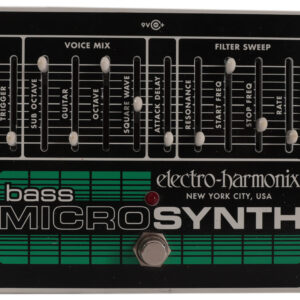Description
The Electro-Harmonix Nano Metal Muff Distortion Pedal is currently retailing at £54.99 and it is in stock. Available to be delivered to you by post direct (some charge may apply).The team at Just Pedals think that Electro Harmonix nailed it with the Electro-Harmonix Nano Metal Muff Distortion Pedal. Electro-Harmonix Nano Metal Muff Distortion Pedal
We have new and used Electro Harmonix musical equipment available on our website for fast direct delivery from sellers across the UK & Europe.
Electro-Harmonix (EHX) is a legendary effects pedal company founded in 1968 by Mike Matthews, known for pioneering some of the most iconic sounds in music history. Based in New York City, EHX offers a vast range of pedals, from the classic Big Muff fuzz and Memory Man delay to innovative effects like the POG and Freeze. Renowned for their creativity, durability, and affordability, Electro-Harmonix pedals have shaped the tones of countless musicians across genres, from rock and punk to ambient and experimental music.
Distortion is a type of guitar effect that alters the sound by adding sustain, harmonic richness, and a gritty or aggressive character. It clips the audio signal, creating a more saturated and powerful tone. Distortion is commonly used in rock, metal, and punk music, offering everything from warm, crunchy overdrive to heavily saturated, high-gain chaos. Unlike overdrive, which mimics the natural breakup of a tube amp, distortion produces a more intense, compressed, and processed sound. Popular distortion pedals include the Boss DS-1, ProCo Rat, and MXR Distortion+.
Just Pedals is a new Guitar Effect Pedals Marketplace – We feature new and used Guitar Effect pedals from different sellers, to purchase online from the UK.
We checked and good news we have it in stock, it has your name on it.
Order today and we will have it with you in a jiffy !
Just the latest videos
Just related products
£59.00
Adjusted distortion pedal for heavy metal. Extensive equalization control, with 14db bass cut or enhancement, 15db mids, and 10db treble. Vol control to adjust the overall output volume. Dist control for input gain adjustment and distortion. Noise ga…
read more
£83.65
Crushing distortion Singing sustain with attitude Compact, rugged nano enclosure True bypass 9-volt battery included, Optional 9.6DC-200 power supply available
£101.00
Wide array of tone shaping options for a unique tone Foot-switchable top boost for screaming leads High-input impedance buffered bypass
£67.98
Reissue of the 1969 classic Muff Fuzz in a die-cast aluminum box Compact, die-cast aluminum package
£93.02 £85.00
Distortion type Vintage fuzz. True bypass. Longer sustain. Fat Fuzz Sound. Made in the USA.





























